Confessions of an Incompetent Leek Farmer
...
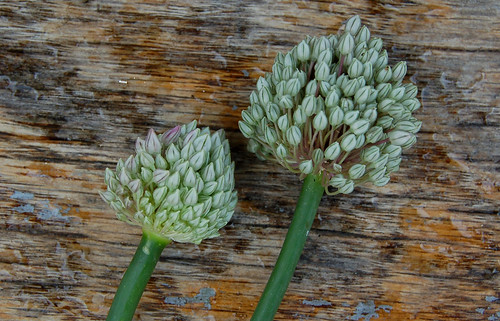
I read a lot of gardening blogs. (To be totally honest, I read a lot of gardening blogs when I ought to be doing something constructive, like sweeping the kitchen floor, or putting away the laundry.)
These blogs can be divided into two categories. There are blogs that offer helpful tips, and present a vision of idyllic bounty, whose gardens don't have a twig out of place, and the only insects present are well behaved beneficial ladybugs, who probably wipe their little feet before climbing onto the aphid-free rosebushes.
And then there are the blogs that I find genuinely interesting.
These are the blogs that honestly chronicle the garden failures, along with the successes. These are the blogs where I actually learn about gardening.
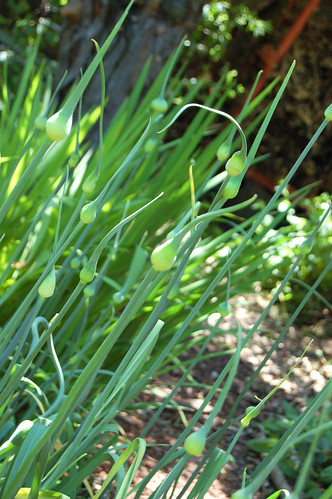
One of my greatest challenges, since starting to garden in Northern California, is trying to understand the growing season. I've lived most of my life on the East Coast, and have gardened in both urban Maryland and rural New York. I had amassed a body of knowledge, based on reading, observing, and screwing up. I had a reasonably good idea of what I was doing, when I put a seed or plant into the ground.
When I first got my hands on a patch of California dirt, I had to throw out all of my assumptions about when to plant. Around here, summer is a dormant period, when no rain falls. Winter, on the other hand is our greenest time of year, with steady rain, and almost no temperatures below freezing.
So, when I decided to plant leeks, I put them in at exactly the wrong time of year. They skipped the getting-big-and fat stage, and went right into the producing-woody-stalks-and-flowers stage of their lives. They never bothered getting succulent. They just headed straight for reproduction. I left them in the ground, and glared balefully at them, willing them to fatten up.
I had about as much luck with this as the Gingerbread Witch had with fattening up Hansel and Gretel. I just couldn't see what I was doing wrong.
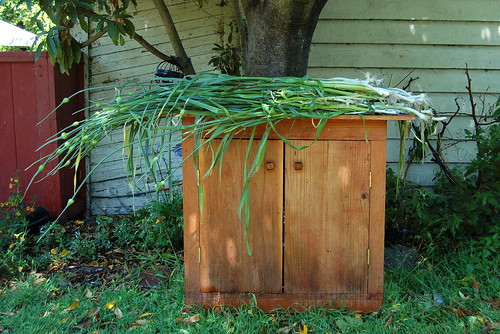
Then, a few weeks back, I went to a class taught by Pam Peirce, the author of Golden Gate Gardening. She's the local expert on the questions of what, where and when. She confirmed my fears that I had been fooling myself, and that my leeks were only getting tougher and that I had better yank them out, as soon as possible.
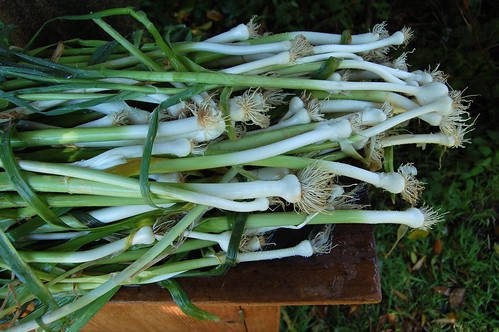
As you can see, my leeks were skinny little things, with lovely flowers on top. Those flowers were in the process of producing seeds for the next generation of leeks. And those flowers were atop thick, woody inedible stalks.
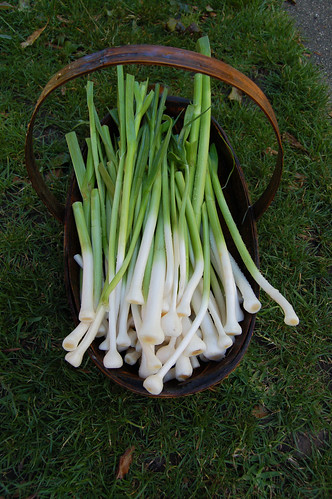
If you look closely, you can see that the center of the leek bulbs have a sort of pinkish color. That's the base of the flower stalk, and is about as food-like as a wooden pencil. Oh well, we worked around the tough bits, and have been enjoying our leeks, in spite of my own amateur mistakes.
I think I've missed my chance for leeks this year, although in the spirit of Misguided Optimism, I stuck in a few baby leeks, just in case. I've been pouring over the planting schedules for our region, and hopefully I'll have better harvests in the future.
I also suck at mushroom gardening, in case you had any doubts about that.

I read a lot of gardening blogs. (To be totally honest, I read a lot of gardening blogs when I ought to be doing something constructive, like sweeping the kitchen floor, or putting away the laundry.)
These blogs can be divided into two categories. There are blogs that offer helpful tips, and present a vision of idyllic bounty, whose gardens don't have a twig out of place, and the only insects present are well behaved beneficial ladybugs, who probably wipe their little feet before climbing onto the aphid-free rosebushes.
And then there are the blogs that I find genuinely interesting.
These are the blogs that honestly chronicle the garden failures, along with the successes. These are the blogs where I actually learn about gardening.

One of my greatest challenges, since starting to garden in Northern California, is trying to understand the growing season. I've lived most of my life on the East Coast, and have gardened in both urban Maryland and rural New York. I had amassed a body of knowledge, based on reading, observing, and screwing up. I had a reasonably good idea of what I was doing, when I put a seed or plant into the ground.
When I first got my hands on a patch of California dirt, I had to throw out all of my assumptions about when to plant. Around here, summer is a dormant period, when no rain falls. Winter, on the other hand is our greenest time of year, with steady rain, and almost no temperatures below freezing.
So, when I decided to plant leeks, I put them in at exactly the wrong time of year. They skipped the getting-big-and fat stage, and went right into the producing-woody-stalks-and-flowers stage of their lives. They never bothered getting succulent. They just headed straight for reproduction. I left them in the ground, and glared balefully at them, willing them to fatten up.
I had about as much luck with this as the Gingerbread Witch had with fattening up Hansel and Gretel. I just couldn't see what I was doing wrong.

Then, a few weeks back, I went to a class taught by Pam Peirce, the author of Golden Gate Gardening. She's the local expert on the questions of what, where and when. She confirmed my fears that I had been fooling myself, and that my leeks were only getting tougher and that I had better yank them out, as soon as possible.

As you can see, my leeks were skinny little things, with lovely flowers on top. Those flowers were in the process of producing seeds for the next generation of leeks. And those flowers were atop thick, woody inedible stalks.

If you look closely, you can see that the center of the leek bulbs have a sort of pinkish color. That's the base of the flower stalk, and is about as food-like as a wooden pencil. Oh well, we worked around the tough bits, and have been enjoying our leeks, in spite of my own amateur mistakes.
I think I've missed my chance for leeks this year, although in the spirit of Misguided Optimism, I stuck in a few baby leeks, just in case. I've been pouring over the planting schedules for our region, and hopefully I'll have better harvests in the future.
I also suck at mushroom gardening, in case you had any doubts about that.
One year ago
Caterpillars and Butterflies
Two years ago
Tidepooling with Friends
Three years ago
Wildfires and Blue-Necked Birds
Four years ago
I'm painting Victorian kennels for a doggy day-care facility
Five years ago
Five hours spent waiting for a scheduled doctor's appointment
Caterpillars and Butterflies
Two years ago
Tidepooling with Friends
Three years ago
Wildfires and Blue-Necked Birds
Four years ago
I'm painting Victorian kennels for a doggy day-care facility
Five years ago
Five hours spent waiting for a scheduled doctor's appointment

Comments